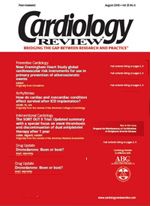Publication
Article
Linking lipid parameters to coronary artery disease in women
The article by Shai and colleagues (page 37) is a complex, elegant analysis of the data linking lipid parameters to future coronary artery disease (CAD) in the Nurses’ Health Study, summarizing and commenting on an article originally published in Circulation.1 The authors analyzed 234 CAD cases and 449 controls from blood samples collected from 32,826 women. They conclude that because of the powerful association of low high-density lipoprotein cholesterol (HDL-C) levels with CAD among women, HDL-C—related ratios, simply the total cholesterol/HDL-C ratio, should be considered as the primary target tool in measures to prevent CAD.
I went to the National Cholesterol Education Program (NCEP) literature to investigate that panel’s rationale for the most recent Adult Treatment Panel III (ATP III) guidelines,2 revised in 2004 after the publication of five major clinical trials. The executive summary of the original NCEP ATP III guidelines can be found in JAMA.3 It is simply stated that current documentation of risk reduction through controlled clinical trials is not sufficient to warrant setting a specific goal value for raising HDL-C. Recent lipid-lowering drug trials provide no new evidence in this regard, but new drugs that raise HDL are currently under development.
The ATP III authors acknowledge that post hoc analysis of clinical trials with fibrates, drugs that modestly raise HDL-C, indicates that fibrates reduce the risk for CAD events in patients with high triglycerides and low HDL-C, especially when patients have diabetes or characteristics of the metabolic syndrome. Fibrates may have an adjunctive role in patients with high triglycerides and low HDL, especially in combination with HMG-CoA reductase inhibitors (statins). Earlier concerns about myopathy when statins and fibrates are mixed are lessened by fenofibrate, which does not substantially increase the risk for clinical myopathy in patients treated with moderate doses of statins. Nicotinic acid is another attractive alternative (when tolerated), which can be used alone or in combination with statins to produce a marked reduction in low-density lipoprotein cholesterol (LDL-C) and a rise in HDL-C.
The other side of the coin, not uncommonly encountered in practice, is the woman with both a high LDL-C and HDL-C. It has been my observation that many physicians already use the HDL-C—based ratio to reassure these women that LDL-C lowering is not necessary. In the NCEP report,3 an HDL-C higher than 60 subtracts one point from the Framingham risk score calculation. Thus, under the current guidelines, a high HDL-C will only occasionally alter the recommendation for LDL-C lowering in women at risk for CAD. Further guidance on this point from prospective clinical trials would be useful.
Thus, the study by Shai and colleagues adds to a body of epidemiologic data and post hoc clinical analyses strongly suggesting the importance of HDL-C as a therapeutic target, a hypothesis that will surely be tested with great vigor in upcoming clinical trials of HDL-C—active drugs.
